- Teaching and Learning
- Curriculum Map
Curriculum Map
-
Our play-based and integrated curriculum is influenced by Missouri Early Learning Standards, the National Association for the Education of Young Children and current child development theory. We are inspired by the innovative public preschool system of Reggio Emilia, Italy, that emphasizes respect for each child and the child’s ability to influence his or her own learning. Children’s prior experiences, backgrounds and early theories are starting points for this inquiry-based education.
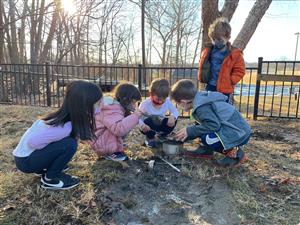 Our Family Center teachers work closely with Clayton kindergarten teachers and other district colleagues. These relationships support children's transition from pre-kindergarten, ongoing curricular development and teacher professional learning.
Our Family Center teachers work closely with Clayton kindergarten teachers and other district colleagues. These relationships support children's transition from pre-kindergarten, ongoing curricular development and teacher professional learning.The Early Childhood Education curriculum framework includes five strands/units of study. Click on each of the strands below for a detailed description.
-
Social Emotional Development and Approaches to Learning
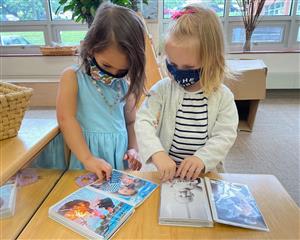 Social-emotional development focuses on the child’s increasing capacity to understand and regulate emotions, feel and show empathy for others, establish and maintain positive relationships with peers and adults and make responsible decisions. By playing and working with each other, children practice their social skills with guidance and support from adults and peers.
Social-emotional development focuses on the child’s increasing capacity to understand and regulate emotions, feel and show empathy for others, establish and maintain positive relationships with peers and adults and make responsible decisions. By playing and working with each other, children practice their social skills with guidance and support from adults and peers. Children’s attitudes and approaches to learning also influence their ability to learn. These include curiosity, initiative, interest, creativity, inventiveness, confidence, persistence and problem-solving skills. The child with a strong foundation in social relationships and a positive attitude and approach to learning is on his or her way to becoming a life-long learner.
You see the social-emotional development and approaches to learning curriculum in action as children…
- build relationships with adults and peers
- begin to feel and show empathy and respect for others
- work and play with one another throughout the day
- come together as a class for large group times such as music or group meetings, or to read together and begin to follow group norms
- show curiosity by asking questions and displaying an interest in learning new things
- work to manage emotions and solve problems
- practice sharing materials with peers
- explore and make connections with classroom materials and engage in a variety of experiences
- engage with open-ended materials that stretch their creativity
- practice skills that promote independence and persistence such as getting their coat from their cubby, cleaning up after snack, helping the group at clean up time, pursuing challenges, or sustaining attention to a task for an extended period of time
- begin to take initiative as they practice making decisions throughout the day, move through routines independently, and initiate play with others
-
Language and Literacy
 Language and literacy development focus on the child’s growing ability to use oral and written language to convey feelings and desires, interact with others, ask questions, think about things, represent what he or she knows, and talk about imaginary situations. The continuous development of oral language forms the basis from which children begin to explore and experience written language. Early and emergent writers and readers use a variety of means to communicate such as conventional signs and symbols (scribbles, mock letters, letters), visual art forms (painting and drawing) and other materials such as blocks, clay and collage.
Language and literacy development focus on the child’s growing ability to use oral and written language to convey feelings and desires, interact with others, ask questions, think about things, represent what he or she knows, and talk about imaginary situations. The continuous development of oral language forms the basis from which children begin to explore and experience written language. Early and emergent writers and readers use a variety of means to communicate such as conventional signs and symbols (scribbles, mock letters, letters), visual art forms (painting and drawing) and other materials such as blocks, clay and collage.You see the language and literacy curriculum in action as children...
- participate in group story time as well as look at books independently and with others
- engage in conversation with others throughout the school day, use words to communicate thoughts and ideas, and begin to ask and answer questions
- explore a variety of writing and drawing materials and art media, including cutting with scissors, using markers and tape to make a message for a friend, working with clay, or creating a collage
- practice forming letters and drawing when making a message, writing their name, creating birthday cards, or drawing how something works
- practice recognizing their name and friends’ names in print, such as finding their cubby or finding their name card at the snack table or at a morning meeting
- express their ideas through writing and drawing, such as sharing a picture plan for a block building, drawing what happened to the decomposing pumpkin in the garden, or making a book
-
Science and Nature Education
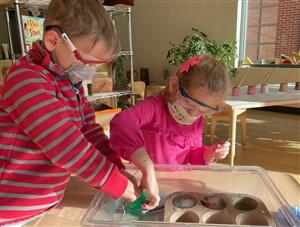 Science and nature education provide open-ended experiences that expose children to the possibilities that exist within the physical and natural world. By participating in these experiences, children practice observing, investigating, predicting, questioning, hypothesizing, and solving problems. As they explore, children begin to deepen their understanding of the characteristics of living things, the physical properties of objects and materials, and properties of our earth. Nature education provides children with a foundation for a life-long relationship between themselves, the earth and its natural resources.
Science and nature education provide open-ended experiences that expose children to the possibilities that exist within the physical and natural world. By participating in these experiences, children practice observing, investigating, predicting, questioning, hypothesizing, and solving problems. As they explore, children begin to deepen their understanding of the characteristics of living things, the physical properties of objects and materials, and properties of our earth. Nature education provides children with a foundation for a life-long relationship between themselves, the earth and its natural resources.You see the science and nature education curriculum in action as children...
- experiment with balance, gravity, and cause and effect as they build in the block area
- observe, explore, and investigate living things in the nature space, gardens, and on the playground
- begin to make predictions, ask questions, and hypothesize as part of the inquiry and problem-solving process
- work in the garden to plant, care for, and harvest herbs, vegetables and flowers
- engage in cooking experiences
- investigate various materials and their properties at the sensory and light tables
- participate in a variety of science experiments
- begin to represent and communicate observations in a variety of ways
-
Mathematics
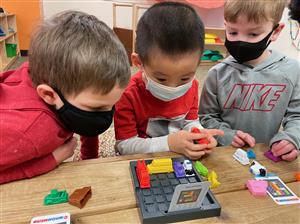 Mathematics focuses on the child’s increasing ability to coordinate thinking processes and mental frameworks around mathematical concepts and problem solving. Through active participation in a variety of experiences children begin to develop an awareness of numbers and operations, geometry and spatial sense, patterns and relationships, and measurement.
Mathematics focuses on the child’s increasing ability to coordinate thinking processes and mental frameworks around mathematical concepts and problem solving. Through active participation in a variety of experiences children begin to develop an awareness of numbers and operations, geometry and spatial sense, patterns and relationships, and measurement.
Children begin to:- Name, count, quantify, and organize objects and events in terms of similarities, differences, and other relationships
- Describe materials, events, and phenomena in terms of number, shape, texture, size, weight, color, and motion
- Demonstrate an understanding of objects and events in spatial and temporal terms: flow of the day, calendar, seasons, holidays, and birthdays
- Perceive number of items in a group without counting (subitize)
- Take objects apart and puts them back together
- Estimate and then count to verify number of objects
- Recognize patterns
- Explore measurement using a variety of objects
-
Music, Movement and Dramatic Play
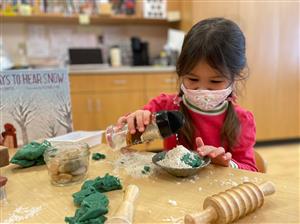 Music, movement and dramatic play enhance the child’s growing capacity for creative expression. Music offers children the opportunity to express themselves melodically and rhythmically. Children respond to a variety of songs, finger plays and instruments as they discover different ways to use their voices and bodies. Children use their bodies to move expressively as they develop a sense for where their body is in space as well as in relation to others. Imaginative role-play provides children with the opportunity to accept, assign, and act out roles. Children may pretend to be someone or something different from themselves and dramatize situations and actions to go along with their chosen roles.
Music, movement and dramatic play enhance the child’s growing capacity for creative expression. Music offers children the opportunity to express themselves melodically and rhythmically. Children respond to a variety of songs, finger plays and instruments as they discover different ways to use their voices and bodies. Children use their bodies to move expressively as they develop a sense for where their body is in space as well as in relation to others. Imaginative role-play provides children with the opportunity to accept, assign, and act out roles. Children may pretend to be someone or something different from themselves and dramatize situations and actions to go along with their chosen roles.You see the music, movement, and dramatic play curriculum in action as children...
- experience singing songs, dancing, performing fingerplays and chants, playing musical instruments and moving to music
- explore and experiment with expressive movement, such as moving their body fast/slow, stopping/starting or pretending to be an animal
- begin to engage in pretend play with peers, such as going on a trip or to a restaurant, offering play food to a doll, or stirring pretend soup
- use their imagination and creativity when working with open-ended materials, such as using blocks to create a zoo and assigning roles in their pretend play
- practice skills that promote gross motor development, such as running, jumping, climbing, balancing, riding a bicycle, and going up and down stairs

